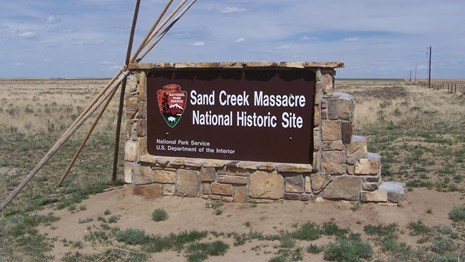
NPS Photo Two Parks Linked by Tragic EventsAt first glance, Sand Creek Massacre National Historic Site (NHS) in Colorado has little in common with the Castillo de San Marcos National Monument (NM) in Florida. Separated by 1,600 miles, these two units of the National Park Service represent uncommon places linked through common bonds of turmoil, suffering, sadness, death, survival, and hope. Massacre at Sand Creek and Internment at Fort MarionOn November 29, 1864, peaceful Cheyenne and Arapaho camped on Big Sandy Creek, in southeastern Colorado, were attacked by units of the Colorado (U.S.) Volunteer Cavalry. The village, which had been assured protection by the Army, was under a U.S. flag and a white flag of truce. About 230 Cheyenne and Arapaho, mostly women, children and elderly, were killed and many of their bodies mutilated. Approximately 500 escaped, some mortally wounded. When the Sand Creek Massacre occurred, the Spanish-built Castillo de San Marcos was nearly 200 years old. Renamed Fort Marion by the U.S. Army in the 1820s, fort storerooms were converted into prison cells and were used later to incarcerate many American Indian tribal members, including the Apache, Arapaho, Caddo, Cheyenne, Comanche, Kiowa, and Seminole. Cheyenne and Arapaho PrisonersAfter the Sand Creek Massacre, Cheyenne and Arapaho survivors scattered. Remnant camps were later forced onto reservations in Indian Territory (Oklahoma). In 1875, thirty-four men and one woman were accused of being ringleaders and murderers in recent fighting and arrested at their agency. Most of them had survived the Sand Creek Massacre, and now they found themselves prisoners -- banished without trial, shackled and loaded onto trains. For these individuals, the trip east was filled with heartbreak and fear. They traveled from Fort Sill, by way of Missouri, Kentucky, Tennessee, and Georgia to Florida, where the prisoners entered the City of St. Augustine, abutted by the ancient fortress Castillo de San Marcos -- Fort Marion. Captivity, Reform and ReleaseOn May 11, 1875, the War Department issued Special Order 88, placing Plains Indian prisoners under the charge of Brevet Captain Richard Pratt, 10th Cavalry. Pratt would be jailer, advisor, and overseer for the captives throughout their time at Fort Marion and beyond. His policy of military regimentation was typical of the time, but his insistence on Indian reform through classroom training, chapel services, and social outings was revolutionary. The idea of transforming the “Indian” rather than driving them toward extinction was central to Pratt’s method of reform. Pratt encouraged industry -- not only manual labor and economic pursuit, but artistic expression. Supplied with paper, often large ledger books, young Cheyenne men like Making Medicine, Bears Heart, Howling Wolf, Cohoe, and the Kiowa Paul Zotom produced pictographic styled images now referred to as Ledger Art. Descendents of Prisoners Work to Preserve HistoryMedicine Water and his half-brother Cometsevah were survivors of both the Sand Creek Massacre and imprisonment at Fort Marion. Buffalo Calf, or Mochi, the wife of Medicine Water, was also a survivor of Sand Creek and the only Cheyenne female prisoner sent to Fort Marion. Their great-great grandson, Red Tail Hawk, became a pre-eminent historian on the Sand Creek Massacre and Fort Marion, assisting in efforts to gather family stories about each place. Chief Whistling Eagle (Laird Cometsevah), great grandson of Cometsevah, was a long-standing leader in efforts to acquire land at Sand Creek and establish Sand Creek Massacre NHS. The LegacyEtched into the old coquina walls of the Castillo de San Marcos are engravings made by some of the prisoners - powerful reminders of their presence in a structure that spans nearly three hundred and fifty years of recorded history. Today, Cheyenne and Arapaho gather annually at Sand Creek to honor and remember those lost during the massacre. Memorialization plays a powerful role at both parks. Castillo de San Marcos NM and Sand Creek Massacre NHS will always be sacred symbols of ancestral sacrifice and humility, places to honor the living and the dead, places where their history will never be forgotten. |
Last updated: May 21, 2020
